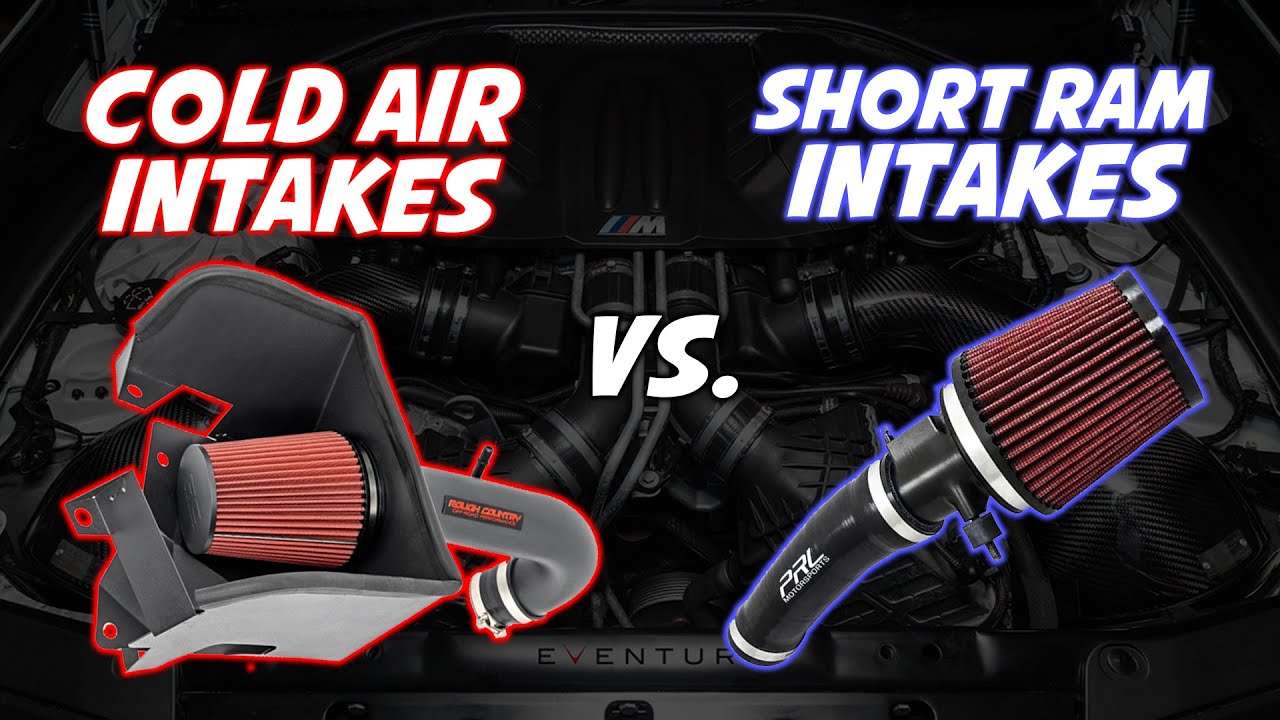A cold air intake is better than a short ram intake due to its ability to draw in cooler, denser air, resulting in increased horsepower and improved engine performance. Cold air intakes are designed to provide a continuous flow of cool air to the engine, optimizing combustion and enhancing overall performance.
With a short ram intake, on the other hand, the air intake is closer to the engine, resulting in hotter, less dense air being drawn in, which can lead to reduced power.
Table of Contents
Therefore, when it comes to choosing between a short ram intake and a cold air intake, the latter is the better option for improved engine performance and power.
Performance
When it comes to upgrading your car’s performance, choosing between a short ram intake and a cold air intake is a common dilemma.
Both options have their advantages and drawbacks, but one area where they differ significantly is in their impact on engine performance.
Let’s take a closer look at how these two intakes affect the overall performance of your vehicle.
Effect On Engine Performance
Upgrading your car’s intake system can have a direct impact on its engine performance. While a short ram intake focuses on maximizing airflow efficiency within a short distance, a cold air intake aims to deliver cooler air to the engine for greater power output.
The design of a short ram intake allows for more rapid throttle response due to its reduced air path, which can result in improved acceleration.
On the other hand, a cold air intake pulls air from outside the engine compartment, providing denser and cooler air, leading to increased horsepower and torque.
Impact On Horsepower And Torque
The ultimate goal of upgrading your car’s intake system is often to increase the horsepower and torque. When it comes to short ram intakes, the significant advantage lies in their ability to generate more horsepower at higher RPMs.
These intakes typically improve top-end power, making them suitable for drivers who enjoy high-speed performance. In contrast, cold air intakes excel at boosting low-end torque.
The cooler air they deliver to the engine allows for better combustion, resulting in increased torque at lower RPMs, which is beneficial for city driving and towing.
Here’s a concise comparison:
| Short Ram Intake | Cold Air Intake |
|---|---|
| Maximizes airflow efficiency | Delivers cooler air to the engine |
| Improved top-end power | Enhanced low-end torque |
| Rapid throttle response | Greater horsepower and torque |
Ultimately, the choice between a short ram intake and a cold air intake depends on your specific driving preferences and the characteristics you value most in your vehicle’s performance.
Whether you prioritize instant throttle response or enhanced low-end torque, understanding the impact of each intake on your engine’s power can help you make an informed decision.

Efficiency
In the eternal debate of Short Ram Intake (SRI) vs. Cold Air Intake (CAI), one crucial factor to consider is efficiency. The more efficient the intake system, the better the performance of your vehicle. In this section, we will delve into two aspects that affect the efficiency of both intake systems: air temperature variation and the effect on fuel economy.
Air Temperature Variation
The temperature of the air entering your engine has a significant impact on its performance. A colder air intake ensures denser air supply, thereby increasing the oxygen content during combustion.
Cold air intakes (CAIs) are designed to draw in air from outside the engine compartment, where it is typically cooler. This feature helps to reduce the intake air temperature, resulting in improved combustion efficiency.
On the other hand, short ram intakes (SRIs) tend to draw in warmer air from within the engine compartment, as they are located closer to the engine. The warmer air decreases the density of the intake air, which can lead to a slight decrease in overall engine efficiency.
However, it’s important to note that the temperature difference between CAIs and SRIs may not be significant enough to have a noticeable impact on the performance of most vehicles.
Effect On Fuel Economy
The efficiency of an intake system also affects your vehicle’s fuel economy. When it comes to fuel efficiency, the general notion is that a colder air intake can contribute to better fuel economy.
This is because a denser air charge allows for improved combustion and, subsequently, more efficient fuel usage. Cold air intakes (CAIs) are specifically designed to enhance fuel economy by delivering cooler, denser air to the engine.
Short ram intakes (SRIs), on the other hand, may not provide the same level of fuel efficiency as CAIs. As SRIs draw in warmer air from the engine compartment, the combustion process may not be as optimized, leading to slightly higher fuel consumption.
However, it’s important to consider other factors that influence fuel economy, such as driving habits, vehicle type, and overall engine efficiency.
To summarize, both short ram intakes and cold air intakes have their own advantages and considerations when it comes to efficiency.
While cold air intakes generally offer better performance due to colder, denser air supply, the difference may not be significant enough for everyday driving.
Ultimately, it’s crucial to choose an intake system that aligns with your specific vehicle and driving needs, taking into account factors beyond just efficiency.
Environmental Factors
When it comes to choosing between a short ram intake and a cold air intake, environmental factors play a significant role in the decision-making process. Both types of intakes have their own emissions impact and environmental sustainability aspects to consider.
Emissions Impact
The emissions impact of a short ram intake versus a cold air intake largely depends on the type of driving conditions and the design of the vehicle’s engine. Short ram intakes typically deliver a more direct airflow to the engine, often resulting in improved fuel efficiency and reduced emissions under normal driving conditions.
On the other hand, cold air intakes draw in cooler, denser air from outside the engine bay, which can lead to improved combustion and reduced emissions, especially in high-performance driving scenarios or extreme temperatures.
Environmental Sustainability
- Short ram intakes are generally more compact and easier to install, reducing the overall consumption of materials and resources during the manufacturing process.
- Cold air intakes, while offering potential performance benefits, may require more complex manufacturing processes and materials, potentially impacting environmental sustainability.
Considering the emissions impact and environmental sustainability, it is essential to weigh the pros and cons of each type of intake to make an informed decision about their environmental impact.
Cost And Installation
When considering between Short Ram Intakes (SRI) and Cold Air Intakes (CAI), Cost and Installation play a significant role in decision-making.
Price Comparison
| Intake Type | Price Range |
| Short Ram Intake (SRI) | $50 – $200 |
| Cold Air Intake (CAI) | $150 – $400 |
Installation Complexity
- SRI: Simple installation, usually a direct swap for the stock intake.
- CAI: More complex installation due to routing of the intake for optimal cold air entry.
Vehicle Application
Vehicle Application:
Compatibility With Different Car Models
A short ram intake is suitable for compact car models, while a cold air intake tends to work better with larger vehicles.
Terrain Suitability
- Cold air intakes are favored for off-road driving due to better filtration of dirt and debris.
- Short ram intakes are ideal for city driving as they provide quicker throttle response.

Maintenance
Maintenance is a crucial aspect to consider when choosing between a short ram intake and a cold air intake. The maintenance requirements, including cleaning and long-term care, play a significant role in the performance and durability of your intake system.
Cleaning Requirements
Both short ram intakes and cold air intakes require regular cleaning to ensure optimal performance. When it comes to cleaning, short ram intakes are generally easier to access and maintain.
Their simpler design typically involves a direct path to the air filter, making it quicker and simpler to clean and re-oil the filter as needed.
On the other hand, cold air intakes may have a more complex design, with the air filter located in a remote or enclosed area, which can make the cleaning process more challenging and time-consuming.
Long-term Maintenance
Long-term maintenance for short ram intakes involves routine inspection and replacement of the air filter as necessary.
With proper care, short ram intakes can provide reliable performance for an extended period. Conversely, cold air intakes may require more elaborate maintenance over time.
Due to their extended piping and complex design, checking for cracks, leaks, and ensuring all connections remain secure is vital to their efficiency and longevity.
Frequently Asked Questions
What Are The Benefits Of A Short Ram Intake?
Short Ram Intakes improve throttle response and engine sound. They are easier to install and cost-effective for performance gains.
How Does A Cold Air Intake Differ From A Short Ram Intake?
Cold Air Intakes draw cooler air from outside the engine bay, increasing horsepower. Short Ram Intakes pull in warmer air from the engine compartment.
Is A Cold Air Intake Better For Performance Than A Short Ram Intake?
Overall, Cold Air Intakes tend to provide better performance gains due to cooler air intake temperatures, resulting in increased power output.
Conclusion
Both short ram intake and cold air intake have their own benefits. It ultimately depends on your specific needs and goals for your vehicle. Consider factors such as budget, performance, and the climate you live in when making this decision.
Ultimately, choose the intake system that aligns best with your driving style and preferences.




